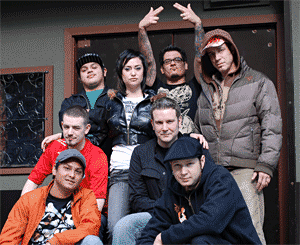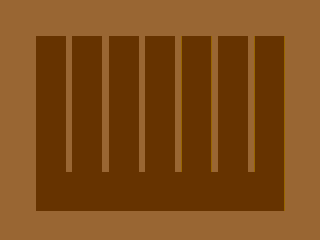Thursday, November 23, 2006
Tuesday, November 14, 2006
SF Weekly: Dubstep Feature
 Dawn of Dubstep
Dawn of DubstepWill this bass-heavy dance phenomenon blow out only your speakers or will it really blow up?
By Darren Keast
Local dubstep crew (clockwise from bottom left): DJ Cyan, MC Child, Sam Supa, Kozee, Juju, DJ Ripple, Miro Wiesner, Djunya. (Photo by Angela Poole)
Local promoters of dubstep, the latest mutation of underground U.K. dance music, seem to engage in similar anxious pre-show rituals. Having taken the plunge with a lineup of a genre alien to even most full-time clubbers, they'll peel the labels off their beer bottles. They might survey the sparsely peopled club a few times and then talk hurriedly to the door person. They will fret and fidget.
Sam Supa, who helped host a recent Pioneers of Dubstep showcase at the Darkroom, excused himself from an early evening interview due to raw nerves. DJ, producer, and promoter Juju, who recently began adding a monthly dubstep night (called Narco Hz) to his eight-year-running drum-and-bass party Phuturo, also admits to acute stress. "I do it every time .. I pace and I drink a lot," he says. "I never know how people are going to take it."
So what's with the nail-biting, especially considering that dubstep has been held up by some as dance music's savior from redundancy? The BBC, after all, has described the scene in its London epicenter as the most vibrant, populist movement to emerge from British clubs in years. And Burners this Labor Day were abuzz over "that weird shit" breakbeat raver-celebs Lorin and Freq Nasty were mixing into their sets. Lorin, who now probably has the largest cult following of any DJ in San Francisco, has been sprinkling dubstep into sets sparingly, but he's also been hitting up local dubstep producer Djunya for anything he's got.
This new-music-as-exotic-additive is one thing; the genre as an entree is quite another. On first listen, the tunes have a funny way of baffling, physically disorienting, and prompting the newbie to look up and demand, "Now what in the hell is that?" Newbies are most likely to stumble over the bass line, which uncoils from the woofers with all the delicacy of a python engorged after a large meal. Then it just lies there in the lowest frequencies, sluggish and perverse. The heaviness might roll over, stretch out a bit, and wobble up to the mid-range for a beat or two, but only to ooze back into the sub-bass murk again.
This bass line didn't just slither out of nowhere, though .. it has a traceable genealogy in Jamaican roots and dub reggae, and drum-and-bass once provided it shelter. "But drum-and-bass almost completely lost it," says Juju, who is still booked to play drum-and-bass across the country every weekend. "You don't hear that 50 Hz kicking you right in the face anymore. That's what brought me to dubstep, which kicks you in the face on every track."
Miroslav Wiesner, the other half of the Pioneers outfit, has a grand plan to seed a proper dubstep scene in San Francisco (which so far follows New York as the American city most supportive of the heavily South London concentrated sound). He created a flowchart placing it at the nucleus of five distinct scenes: drum and bass; "breaks + Burning Man;" minimal techno/glitch; grime and 2-Step, the über-urban British club subculture that many of dubstep's founders started in; and "dub + desi," the South Asian-meets-reggae movement represented locally by the Dhamaal crew.
But even that complicated taxonomy fails to adequately define the sound for him. "I like to quote Joe Nice when explaining it," Wiesner adds, referring to the Baltimore DJ called dubstep's American ambassador. "He said, Dubstep is space, pace, and bass.' Space, as in the large amount of white space between samples; pace, as in this narrow band of 138-142 BPM that the tracks are made in; and bass, as in unless it has massive sub-bass, it doesn't work."
"Space" could also refer to its sonic tone and mood, which match that of the inkiest, loneliest of black holes. The best work of dubstep's South London vanguard .. Skream, Loefah, Benga, Kode 9, Digital Mystikz .. conjures the bleakest Rastafarian-imagined scenes of industrialized society slowly consuming itself. Because of its apocalyptic vibe and unusual shuffling rhythms, even dubstep partisans have wondered about its viability for local dance floors. Maneesh the Twister, co-founder of Dhamaal and veteran DJ of eclectic dub-based beats, says, "One criticism I've heard is how can you play dubstep at 1 or 2 a.m. when people want to really dance?' People haven't quite figured out how to move to it .. they kind of wobble up and down and let the bass do its thing." He takes a spoonful-of-sugar approach: "I try to bring in something they already understand .. reggae .. and then mix dubstep into that."
But those predicting hopelessly flummoxed or sedentary consumers of dubstep changed their tune after the Pioneers of Dubstep night, which featured local DJs Cyan, Subtek, Ripple, and the Santa Cruz based Argon Records crew opening for prominent British headliners Youngsta and Hatcha. The promoters were pleasantly stunned to see a packed house at peak hour, with people crying out in glee and dancing a sort of nasty limbo as the bass slunk ever downward. Even a uniformed sailor who had wandered in from Fleet Week furlough couldn't sit still. Sea legs, in fact, might be the right preparation for extended dubstep exposure .. thighs tend to burn and knees buckle after an hour or two of such dancing.
"We proved that you can do 5 1/2 hours of solid dubstep and keep people on the dance floor," Wiesner says. "We might not be able to throw a pure dubstep night of that size more than once every few months, but we have a long-term outlook."
Staying power, however, is just what many of the genre's ancestors lacked. Most clubbers have been calling drum-and-bass dead for years, 2-Step failed to score much more than a blip on San Francisco's radar, and the monthly Grime City party has shifted its emphasis from its namesake to dubstep even before its two-year anniversary. The electronic music faithful have been so eager for fresh ideas that they treat any new sound as the next messiah, and in so doing, tend to smother it.
"There's definitely some resistance from some people in the drum-and-bass community," says Ryan Romana, who spins both dubstep and drum-and-bass as DJ Cyan. "They say dubstep is just a trend, and they joke that we're traitors."
Weisner has also felt an early backlash. "The vibe I get on the online forums is, Talk to me next year. I lived through garage; I lived through 2-Step and grime. I'll see you at the other end, and I'll still be playing my drum-and-bass tunes.'"
Dance music's chattering classes have been ambivalent as well. San Francisco's XLR8R magazine became a major cheerleader early on, running a dubstep cover story in 2002 that helped certify the emerging genre's name. But Simon Reynolds, author of Generation Ecstasy, dismissed dubstep's "bass theology thing" as "a bit tired" and having "something of a lived-in air about [it] at this late hour" on his blog. Vice magazine called the recent dubstep collection War Dubz "the perfect compilation for anyone who likes to spend their evenings sulking in a darkened room with lots of other stoned weirdos."
So will dubstep join broken-beat, electroclash, and grime as the next electronic sub-genre that's killed before it even reaches adolescence?
Maneesh thinks not. "It seemed like with electroclash and grime, nobody I knew in San Francisco was really making it. That's the major difference; [local] people here are making dubstep," he says, pointing to Juju and Djunya, who have been releasing tracks on the former's Narco Hz label and getting spins from British heavyweights. Matty G of Argon Records produces a signature West Coast rap influenced dubstep, and San Francisco's Kozee .. one of very few female dubstep DJs .. says she's buying gear to make her own tunes, too.
The British expat MC Child, who co-founded Grime City and is the go-to vocalist for any local dubstep or grime show, thinks that the global scene is also well structured for weathering faddishness. "Since the music is so relaxed and warm, people act like family," he explains. He recently flew home to Brixton to check out the definitive dubstep party, DMZ, and found it to be incredibly inclusive. "The scene is still underground, so you don't have the hipsters or the big egos yet. Both will come .. they always do. But the cool thing is, there's a place for them. As long as you don't have aggressive vibes, you'll be welcomed."
Plus, he says, death of dance music subcultures is an illusion. "There's still garage, there's still grime, there's still drum-and-bass," he says. "The music doesn't go away, it just goes in and out of the public eye. With dubstep, it's not going away .. it's been around in other forms for at least six years; it's just that now it has an identity. If it disappears from the public eye, cool. It'll be like going back to your favorite bar after the cool people got tired of it."
Show Details
Who / What: Grime City
Music Date: Friday, Nov. 17
Music Genre: DJ/Electronic Music
Details: Admission is free; call 543-3505 or visit www.anu-bar.com for more info. Also, on Tuesday, Nov. 21, you can check out Narco Hz featuring Juju, Djunya, Subtek, and DJ Cyan at Underground SF at 10 p.m. Admission is $5; visit www.undergroundsf.com for more info.
Where: Anù
Labels: Publicity


